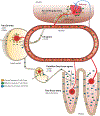Tissue-Resident T Cells and Other Resident Leukocytes
- PMID: 30726153
- PMCID: PMC7175802
- DOI: 10.1146/annurev-immunol-042617-053214
Tissue-Resident T Cells and Other Resident Leukocytes
Abstract
Resident memory T (Trm) cells stably occupy tissues and cannot be sampled in superficial venous blood. Trm cells are heterogeneous but collectively constitute the most abundant memory T cell subset. Trm cells form an integral part of the immune sensing network, monitor for local perturbations in homeostasis throughout the body, participate in protection from infection and cancer, and likely promote autoimmunity, allergy, and inflammatory diseases and impede successful transplantation. Thus Trm cells are major candidates for therapeutic manipulation. Here we review CD8+ and CD4+ Trm ontogeny, maintenance, function, and distribution within lymphoid and nonlymphoid tissues and strategies for their study. We briefly discuss other resident leukocyte populations, including innate lymphoid cells, macrophages, natural killer and natural killer T cells, nonclassical T cells, and memory B cells. Lastly, we highlight major gaps in knowledge and propose ways in which a deeper understanding could result in new methods to prevent or treat diverse human diseases.
Keywords: T lymphocytes; immunity; lymphoid cells; memory; residence.
Figures





Similar articles
-
CD4+ Memory T Cells at Home in the Tissue: Mechanisms for Health and Disease.Front Immunol. 2018 Oct 16;9:2394. doi: 10.3389/fimmu.2018.02394. eCollection 2018. Front Immunol. 2018. PMID: 30386342 Free PMC article. Review.
-
Tissue-resident lymphocytes: from adaptive to innate immunity.Cell Mol Immunol. 2019 Mar;16(3):205-215. doi: 10.1038/s41423-018-0192-y. Epub 2019 Jan 11. Cell Mol Immunol. 2019. PMID: 30635650 Free PMC article. Review.
-
The evolving role of tissue-resident memory T cells in infections and cancer.Sci Adv. 2022 Aug 19;8(33):eabo5871. doi: 10.1126/sciadv.abo5871. Epub 2022 Aug 17. Sci Adv. 2022. PMID: 35977028 Free PMC article. Review.
-
The Role of CD4+ Resident Memory T Cells in Local Immunity in the Mucosal Tissue - Protection Versus Pathology.Front Immunol. 2021 Apr 21;12:616309. doi: 10.3389/fimmu.2021.616309. eCollection 2021. Front Immunol. 2021. PMID: 33968018 Free PMC article. Review.
-
CD4+ resident memory T cells dominate immunosurveillance and orchestrate local recall responses.J Exp Med. 2019 May 6;216(5):1214-1229. doi: 10.1084/jem.20181365. Epub 2019 Mar 28. J Exp Med. 2019. PMID: 30923043 Free PMC article.
Cited by
-
Single-Cell RNA Sequencing Reveals Tissue Compartment-Specific Plasticity of Mycosis Fungoides Tumor Cells.Front Immunol. 2021 Apr 21;12:666935. doi: 10.3389/fimmu.2021.666935. eCollection 2021. Front Immunol. 2021. PMID: 33968070 Free PMC article.
-
Insights from integrating clinical and preclinical studies advance understanding of graft-versus-host disease.J Clin Invest. 2021 Jun 15;131(12):e149296. doi: 10.1172/JCI149296. J Clin Invest. 2021. PMID: 34101618 Free PMC article. Review.
-
A novel humanized mouse model to study the function of human cutaneous memory T cells in vivo in human skin.Sci Rep. 2020 Jul 7;10(1):11164. doi: 10.1038/s41598-020-67430-7. Sci Rep. 2020. PMID: 32636404 Free PMC article.
-
Impact of aging on the frequency, phenotype, and function of CD4+ T cells in the human female reproductive tract.Front Immunol. 2024 Sep 12;15:1465124. doi: 10.3389/fimmu.2024.1465124. eCollection 2024. Front Immunol. 2024. PMID: 39328419 Free PMC article.
-
Antigen-Specific Adaptive Immunity to SARS-CoV-2 in Acute COVID-19 and Associations with Age and Disease Severity.Cell. 2020 Nov 12;183(4):996-1012.e19. doi: 10.1016/j.cell.2020.09.038. Epub 2020 Sep 16. Cell. 2020. PMID: 33010815 Free PMC article.
References
Publication types
MeSH terms
Grants and funding
LinkOut - more resources
Full Text Sources
Other Literature Sources
Research Materials

